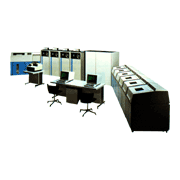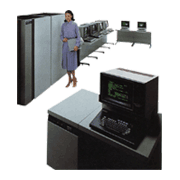These were mid-range computers developed by Mitsubishi Electric and oriented toward interactive processing and distributed processing.
The COSMO 700III and 700S were announced in 1979. These computers used distributed processor architecture in which functions such as system control , arithmetic processing, input/output processing and communications control are distributed to function-specific processors, and these processors were linked with split-cycle type high-speed buses. This provided improved system processing performance and configuration flexibility. In addition to the uni-processor configuration, there was also a tightly coupled multi-processor configuration employing shared memory. The 700III had a built-in high-speed floating-point processor and an array processor (IAP) for high-speed execution of floating point vector operations. NMOS-LSI with 1500 gates and a gate delay time of 2.6ns was used for logic circuits. The maximum main memory capacity was 4 megabytes.
The COSMO 800III and 800S were announced in 1981. These were Mitsubishi Electric's high-performance computers -- designed with much more support for distributed processing, Japanese language information processing and image processing. These machines were equipped with functional engines and state-of-the-art LSI, and could be set up in a tightly coupled multi-processor configuration. In the MELCOM COSMO Series, the 800III and 800S were positioned between the Model 900II and the Model 700III. These machines could be equipped with a variety of functional engines, such as a database engine, VSAM engine, transaction-processing engine or LISP engine, and this improved system performance. ECL-LSI with 1000 gates and a gate delay time of 0.9ns was used for logic circuits, and the basic processing unit had an 8 kilobyte high-speed buffer memory. Maximum main memory capacity was 8 megabytes (or 16 megabytes with multi-processors).



